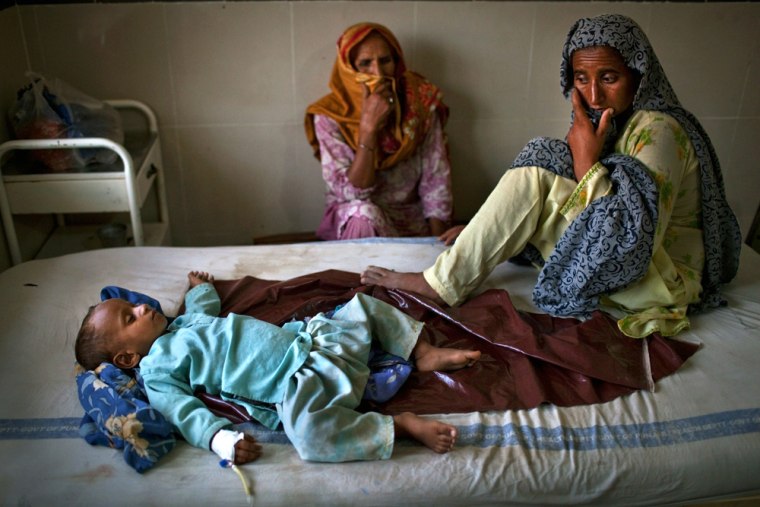After a little-noticed, weeks-long disruption caused by the monsoons that devastated Pakistan, the CIA in recent days has picked up the pace of its missile strikes against Islamic militants, with back-to-back attacks against terror targets that have reportedly killed 26 people, including 7 civilians, in the country’s northwest region.
But the airstrikes have raised fresh concerns among some Pakistani officials that the agency is resuming its lethal campaign at the worst possible moment, in the midst of a humanitarian crisis that has submerged one sixth of the country and left at least six million people homeless.
The U.S. government was building substantial goodwill inside Pakistan by rushing food and helicopters and pledging $150 million — more than any other country — to assist with flood relief, one senior Pakistani official told NBC.
But “all that could go down the drain” if the agency continues with aggressive airstrikes right now, said the official, who asked not to be quoted criticizing the U.S. “It’s one thing if they were getting some high-value targets, but there are many in Pakistan, particularly in the religious parties, who are going to look at this and say, ‘Here we have the worst national calamity in the history of our country and the U.S. is responding by conducting [lethal military attacks]'."
The sharp drop-off in the CIA pilotless drone attacks this month was never publicly confirmed by U.S. officials, mainly because the program — considered by Obama administration officials as their most effective counter-terrorism weapon — remains officially classified.
But the ferocity of the monsoons that hit Pakistan in late July at first made it all-but-impossible to keep the drones in the air, a U.S. official confirmed to NBC.
“You can’t fly in a monsoon,” said the official.
For a 20 day period, between July 25 and Aug. 13, the CIA failed to launch any missile strikes at all, the longest such period this year, according to an analysis by the Long War Journal, a publication that closely tracks the drone campaign. Before the hiatus, the CIA had mounted 49 attacks in 2010, amounting to an average of about two a week.
But in recent days, the CIA has stepped up the momentum of the drone campaign to its pre-flood intensity.
Last Saturday and again on Monday, missiles fired from the CIA’s pilotless drones hit compounds associated with the terror network of militant leader Jalaluddin Haqqani and his son Sirajuddin Haqqani. There have been no public reports of any significant figures killed in the attacks, but the Haqqani network has become one of the CIA’s chief targets in Pakistan: It is closely allied with al-Qaida and is believed to have been responsible for the Dec. 30 bombing of a CIA base in Khost along with multiple other terror attacks over the past year.
The missile strikes took place in an area of Pakistan — north Waziristan — that is not directly impacted by the floods and a U.S. official familiar with the operations said that there is no reason the humanitarian crisis elsewhere in the country should cause any abatement in the U.S. government’s counter-terrorism operations.
“The United States is focused both on humanitarian relief and on counterterrorism. Those aren’t competing priorities,” said the official. “When nothing was flying in Pakistan, nothing flew. But that rather brief period is past, and during that time, the terrorists weren’t doing much on the ground. They weren’t out and about. The key is that our aggressive counterterrorism operations continue.”
Some U.S. counterterrorism experts concur with the agency’s assessment about the need to keep the pressure on the militant groups, especially given the Pakistani military’s unwillingness to go after groups like the Haqqani network on its own. “The extremists have not let up because of the floods, nor should we let up on the pressure,” said Wendy Chamberlin, the former U.S. ambassador to Pakistan.
But Pakistani officials are increasingly nervous that Islamic militants will exploit the floods and use the disaster to their advantage, seeking to capitalize on public anger with the slow pace of relief efforts. Pakistani president Asif Ali Zardari, in an interview with foreign journalists on Monday, called the floods the “ideal hope of the radical.”
In the early days of the flooding, one leading militant group, Lashkar e Taiba, even set up 15 relief camps, scoring a public relations coup at a time when Zardari was being publicly assailed for leaving the country to fly to the United Kingdom. At the same time, the Pakistani Army has been forced to divert an estimated 68,000 troops to flood relief as well as about 28 helicopters that would normally be dedicated to counterterror operations, said the Pakistani official who spoke to NBC.
Just how much of an impact that will have on the overall counterterrorism effort is unclear given that, as some U.S. officials point out, the Pakistani military has been largely resistant to going after the groups the United States most cares about, such as al-Qaida and the Haqqani network.
As if to underscore the intensity of the war that is still raging in spite of the floods, militant groups set off three bombs on Monday that killed 29 people. In one off the attacks, a teenage suicide bomber with explosives strapped on his body detonated them inside a mosque in South Waziristan where 200 worshipers were praying.
